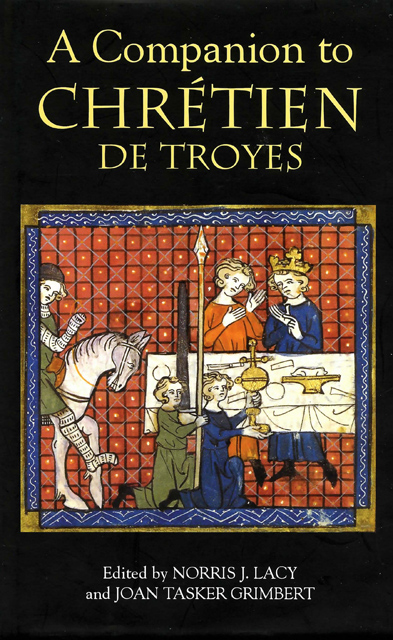2 - Chrétien’s Patrons
Published online by Cambridge University Press: 23 March 2023
Summary
Chrétien de Troyes, whose contribution to twelfth-century literature is unsurpassed, wrote for two of the most notable cultural patrons of his time. Like all literary patronage in the Middle Ages, the respective roles of Chrétien and his patrons represented a reciprocal and mutually beneficial relationship. As a rule, a poet composed at the request of a patron, who in turn provided him with a reward that could take the form of gifts, monetary payment, a position within the court (e.g. clerk, scribe), or the lending of the patron's influence to his work. Although in some instances poets dedicated works to a lord or lady merely in hope of a reward, Chrétien clearly received commissions for the two romances he wrote for identified patrons – Le Chevalier de la Charrette for Marie, Countess of Champagne, and Le Conte du Graal for Philippe d’Alsace, Count of Flanders (hereafter referred to as Philip of Flanders). Marie, he tells us, supplied him with the matiere [material or plot] and san [interpretation] for the Lancelot, while Philip provided the livre [source text] for the Perceval. Chrétien undertook the requested works presumably in exchange for their generosity (or the promise of it).
Chrétien was fortunate to have found such remarkable and educated patrons. Scholars remember Marie de Champagne as one who held a brilliant literary court in the north of France during the last quarter of the twelfth century. The elder of two daughters of the French king, Louis VII, and his first wife, Eleanor of Aquitaine, Marie was born in 1145. Eleanor's two marriages, the second to King Henry II of England, produced ten children, many of whom, particularly the daughters, were responsible for the dissemination of Arthurian materials and the concept of fin’amors [ennobling love] throughout western Europe. In 1153, the year following King Louis's divorce from Eleanor, he betrothed his two daughters, Marie and Alix, to the brother counts of Champagne, Henri the Liberal and Thibaut of Blois. Marie married Count Henri in 1159, when she was fourteen. By birth and by marriage she became a wealthy and powerful woman.
Marie's husband, Henri the Liberal, was a literate and intelligent man who also sponsored much literature before his death, but his tastes, distinctly different from those of his wife, included primarily religious texts written in Latin. Unlike her husband, Marie apparently did not read Latin well and preferred texts in the vernacular. Her requests for biblical translations are among the earliest in French. Marie's independent patronage seems to have occurred primarily during her husband's absence from court on crusade and during her widowhood, that is, from 1179 until her death in 1198. A number of authors wrote about the Countess, including such well-known poets as Gautier d’Arras, Richard the Lion Hearted (her half-brother) and Rigaut de Barbezieux. Andreas Capellanus, author of the treatise on courtly love known as the De Amore, included the Countess as a character in his book, where she rules over courts of love with her mother and other noble ladies. An Andreas Capellanus witnessed nine charters at Marie's court between 1182 and 1186, but since the author of the De Amore wrote in Latin, his work was most likely not composed for her but rather for another audience.
- Type
- Chapter
- Information
- A Companion to Chrétien de Troyes , pp. 15 - 25Publisher: Boydell & BrewerPrint publication year: 2005
- 3
- Cited by

